Warning: This is a long article, so you can take breaks while reading it, as it covers different sections:
- Introduction to Misho (AudioAntiquary) and the Altecs, his background owning Altecs, Bionor, WE 16a, etc
- Compares of his electronics against Audio Note Empress 2a3, Allnic Phono, and comments from users who own it with Kondo and CJ GAT II
- Tour of various other Altecs and VOTTs in EU
- My own decision to go with dual woofer FLHs
On whatsbestforum, audioshark and on Facebook, I was hearing a lot of buzz around an artisan designer named Misho Mironov, an Ukrainian operating out of Bulgaria. Under the brand name audio antiquary, he was designing a wooden 3.5 watts single ended pentode amp, a wooden tube preamp, and a wooden phono (26db MM with SUT).
This is what Paul Yoo had to say about the power amp which es86 and el12 valves: “The Wooden project has no tube sound. I know I know its hard to believe it and describe it. They add nothing to the sound. Huge 3 dimensional sound. The separation is just unreal. Extraordinary sound. My Kondo has bit more fuller and warmer presentation so its bit different but I would ranking the Wooden project equal to Kondo. ” Joeinid on audioshark had the following to say about the preamp with the C3M tube “It has a very natural, open and lively sound with superb vocals. It has layering and depth equal to or better than my CJ GAT2. “
Given each of the phono, preamp, and poweramp was 4k Euro or thereabouts, that was quite a statement.
Stefan Bertoncello wrote https://twogoodears.blogspot.com/2018/07/misho-myronovs-woodenamp-landed-at-my.html?m=1
Recently the same report was on Mono and stereo https://www.monoandstereo.com/2018/07/misho-myronov-tube-woodenamp.html
I had also received feedback from some of his clients, one of them Andy Moore from Australia, who was using the Rullit Atelier single driver DIY speakers. Chatting with Misho, I realized that he also was into Altecs, and I had Altec investigation on my backlog for a while. I immediately hopped on a plane and flew over to Bulgaria to meet Misho and his partner, Yanislav.
Misho had previously been into Tannoys, and had also built himself a Bionor and owned a WE 16a
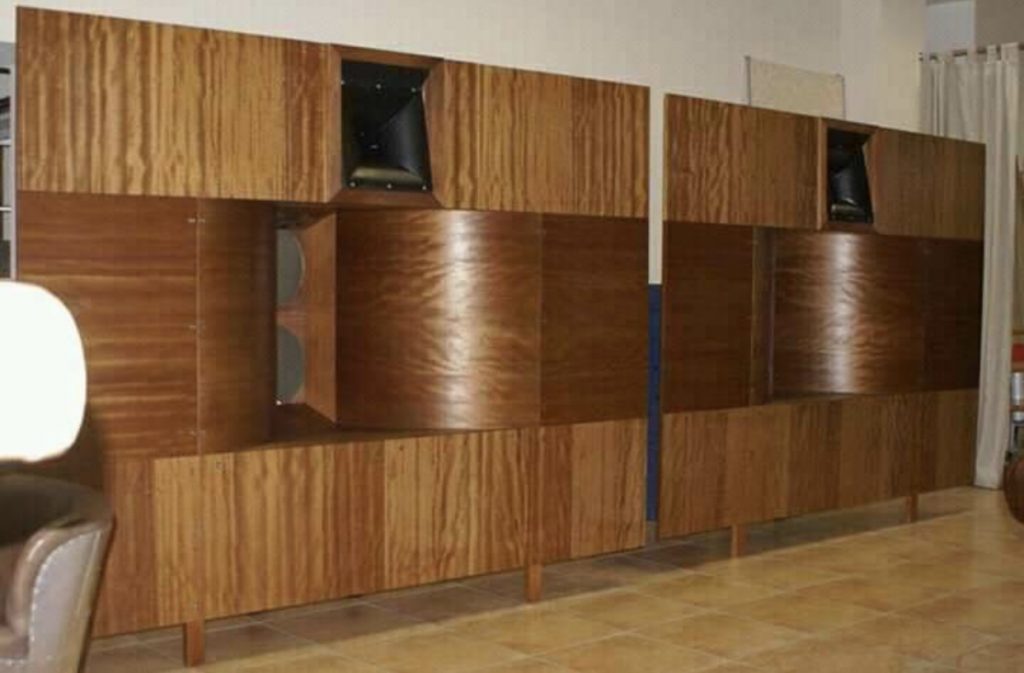
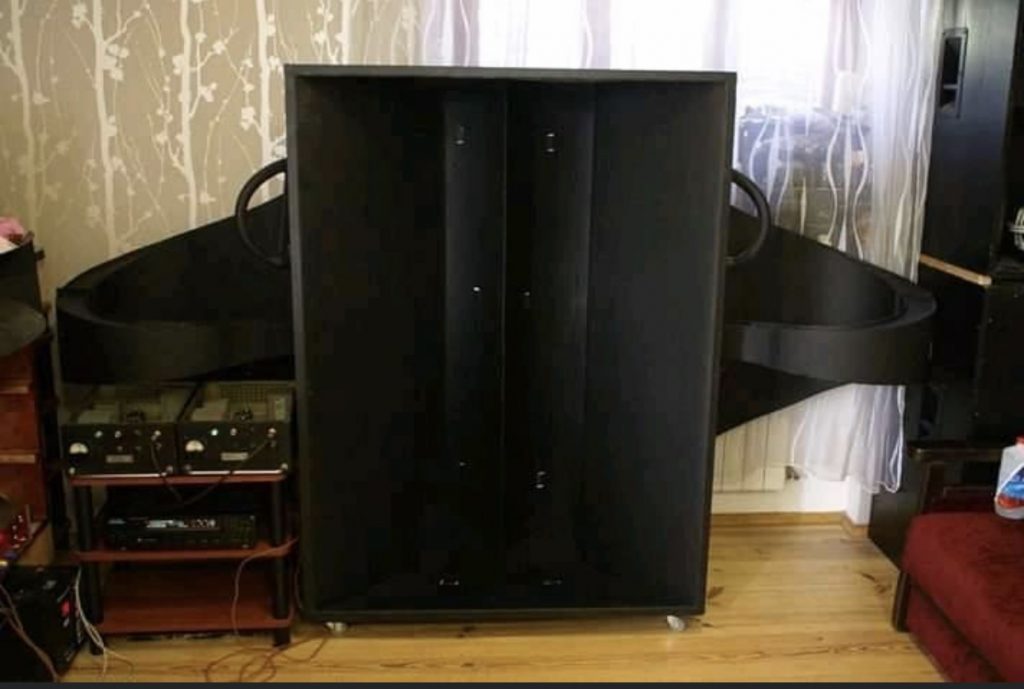
Eventually he had moved to Altecs, and at Yanislav’s place they had built an Altec 817, which has a bass cabinet approx. 1x1x1 meters, housing two 15 inch drivers. On top was the Altec mid-high frequency driver, with Markus Klug’s wooden multicell replicas of altecs.
Altec Background: As a background, there are various Altec models as the co. was formed mid 20th century. Altec split into JBL which morphed into TAD. Altec horns, like western electrics, were made to address large theatre audiences on low wattage valve amps, which were the only ones available in those times. Altec, like vitavox, uses multicell horns for its mid-high frequencies, and the originals were made of metal. Markus Klug’s wooden replicas have recently gained fame, and are much preferred to the originals. I will link to this article my visit to Markus, who also uses Altecs with Misho’s electronics.
Altec 604s are concentric tannoy type drivers usually available in boxes, but also can be used open baffle. Altec coax is more sensitive and is quicker, while vintage Tannoy is slower but has a great earthy tone and needs more power. A5 and A7 are one woofer voice of theaters. Altec 15s, Altec 19s, Altec Valencias, Barcelonas, are all model names you will hear, but it is the 817, 211, 815, which are the big ballsy ones with two woofers in each speaker.
Before this, I had heard a large JBL 4550 (which is the JBL equivalent of a dual woofer VOTT) 5 years ago with JBL 375 Beryllium and JBL Alnico K151 drivers. That remains one of the best speakers I have heard till date, and a similar dual woofer horn with two 18 inchers at Silvercore remains one of my top rooms and one of my best write-ups. I have also heard a VOTT made by David Haighner, and have since heard many others I will eventually write about. The Silbatone GIP horns that are next to the original WEs at Munich are dual woofer FLHs based on similar designs, different drivers.
Yanislav had a Garrard 301 with a Classic SPU on an Ortofon 309, a 401 with Gray’s tonearm and a Shure m3d, and a TD 124 on the floor with a SPU. Interestingly, the 100kg speakers had no impact on the vibration of the electronics and TT that sat on the floor. Yanislav also used tapes and cassette decks for sources (Misho is an expert Nakamichi restorer), so I was able to swap many sources.
From the first note of Oistrakh playing the Scottish Fantasia on Speaker’s Corner, I knew my trip had been more than worth it. The orchestra was blossoming into the room, with weight, energy and pressure on each note, top to bottom. The whole system threw a big concert hall sound, that I would soon realize is a classic Altec trait. It throws a widely dispersed sound with its multicell horn, there is no real sweet spot, and you feel part of a big concert hall.
The system confirmed what I had learned with the JBL and the Silvercore – dual woofer front loaded horns (FLH) when done right are the best midbass in audio, bar none, and provide coherency in the midrange to midbass crossover to match that of a crossoverless great speaker like Yamamura or the Pnoes with AER BD5, i.e. they are far more coherent than anything else in this aspect. The silvercore and the above mentioned JBL might be slightly better on the midbass due to 18 inch woofers, but they are much larger, and therefore need special rooms. The silvercores crossed over at 200 while Altec and TAD based dual woofers crossed over between 500 – 700 (I will write more on TAD in a follow-up article.
Don’t get me wrong, I love some backloaded or downfiring horns, and would live with them happily, but when compared, they don’t stand up to dual woofer FLH.
At Yanislav’s we went through violin concertos, piano concertos, vocals, jazz, and rock. For rock, this was the best rock heard along with Mike Lavigne’s.
For compare to the above, here is a system with Zellaton Plural Evos, Goldmund electronics, and a much higher end analog set up with Fuuga cart.
Like electrostats, horns with beryllium drivers such as Cessaros (TADs), Universum (radians), and AER based Pnoes are top down speakers, i.e. their attraction starts at midrange and highs, and they excel at transparency, nuance, high frequency extensions. They get by despite midbass compromises. Dual woofer FLHs, on the other hand, excel at midbass and are more linear through the midbass. The first thing you notice with them is the breath of the bass, the foundation of the music. The weight and the presence. For me this is the toughest thing to get right, especially in horns and panels, as no one has it at this level; well done dual woofer FLhs beat Henks Apogee Grands in this area, producing an equal weight and slam but with more texture, detail, and tone. Getting the upper frequencies right for me was the easy part once you could navigate this design.
If you research Altecs more, you will see that Joe Roberts, who presents Western Electrics at Munich each year, strongly advocated these on various forums as the best alternative if you cannot afford WEs. They were also touted to have among the best midbass, and the 515 woofers are legendary, and keep appreciating in price.
Further background detail for Altec newbies: Altec has two main woofers, alnico and ferrite, 515 series and 416 series (there are others but these two are the main ones). These further have letters such B, C, E, G, denoting whether they have Alnico or Ferrite motors. And there are the originals, as well as those produced by Great Plains Audio, which is a company started by an ex-Altec engineer with the Altec machinery.
Most experts will advise you that the originals were quite better, so I hunted around and bought two pairs of 515B, the alnico version. Two 515B woofers in parallel add 3 db to take sensitivity to 103, and once horn loaded, a further 6db is added. 16 ohm woofers in parallel takes impedance to 8 ohms. Therefore you get 110db, 8 ohms. Even if you lose some in actual compared to on paper, you will still get 105db. The mid to high frequency can done by small format or large format drivers. The large format drivers are called 1.4 inch drivers because of the size of their exit, while the small format ones are called 1 inch drivers. The large format ones have a 4 inch voice coil. For dual woofers you need the large formats (other brands have large formats in 1.4, or TAD 4003]at 1.5, and Radian 950, JBL 24XX, Gauss, etc at 2 inch exit as well).
Polonius said that In audio, it is pointless to have a system that does not have a 4 inch voice coil or a minimum 15 inch woofer. You might as well take up another hobby, like embroidery or knitting.
Misho’s electronics: I now needed to understand the electronics behind the speakers. I was introduced to Jonathan in London who owned Misho’s electronics on a Altec 604 in open baffle – the below set of speakers cost 2k for the drivers, 600 for the crossover, and some wood.
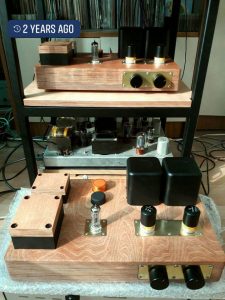
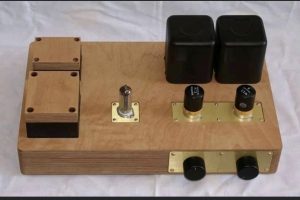
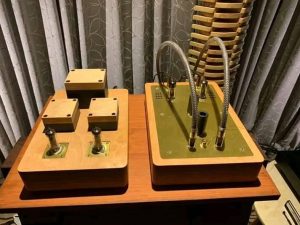
With Jon, We did a Birmingham blitzkrieg, and dropped in at Lee’s who owned the Audio Note Empress 2a3 6w amps on horns mummies. Replacing his passive Haitto pre with Misho’s pre immediately added excitement and soundstage and energy, but the poweramps fell slightly short of the greater oomph that the twice powered AN amps provided
We then took it over to Mark, one of my favourite rooms with the horns universum. Mark is the Ming Da distributor, and also manufactures his own brand of electronics called Audio Detail – his 101d based DHT preamp is one of my favorites – clean, quick, flowing, and transparent. At Mark’s place, what stood out with the AT33 cart was Misho’s phono. When we played the AT33 into my Allnic 7000, the cartridge sounded like a sub-1k cart. However, when played into Misho’s phono coupled to Mark’s preamp, we found that every small detail in the groove came across effortlessly and clear, transparent to the recording, loads of energy and tone. Misho mentioned he uses the Altec/Peerless step ups in his wooden SUT, which amplifies at the microphone level. In fact, after this demo, his phono became my favourite in his product portfolio. The AT33 did not sound like a sub-1000 cart through this, but like a highly detailed, dynamics, musical version of Lyra Atlas.
We then went to Mark’s neighbour, Rob, who owns the horns Symphonia, a hybrid, like the Duos, possibly better and much cheaper. At Rob’s place, we compared Misho’s poweramps to the Tektron GM70 9w poweramps, and while we were surprised at how powerful the 3.5 watts of Misho sounded, they did not have the grunt required for this speaker. However, this demo confirmed my belief in the Altec 817s, as Misho’s 3.5 watts on it were sufficient to run Black Sabbath full tilt.
The phono preamp, while having a separate PSU made in his “classic” wooden style, the RIAA had brass top and botom plates, in order to provide sufficient shielding with some wood inside, and passive split correction circuitry. Tubes were low noise ecc808, ecc82 and 6Н6П, with power supply having independent rails for different stages.
Each of his amps and preamps are designed and made by him, each part, the transformers, circuitry, the layered wood, is all hand made.
Other Altecs and VOTTs: I had to listen to other Altecs, and I joined Melaudia, a French forum that is based on the Hiraga philosophy for designing horns, especially Altecs, and where many users use DIYed electronics based on Hiraga and Kaneda principles. Hiraga also had special crossovers for his Altec, which many Altec enthusiasts have adopted. A journey from Toulouse to Brittany through a group of addicted DIY enthusiasts.
First up was Raoul in Toulouse with the Altec 288C, Hiraga crossovers, and a Philips multicell horn, detailed here http://forums.melaudia.net/showthread.php?tid=2443&pid=15689#pid15689
One of the unique things I heard was the bass section of Regis built into the concrete wall, each with four Altec 15 inch woofers in each speaker
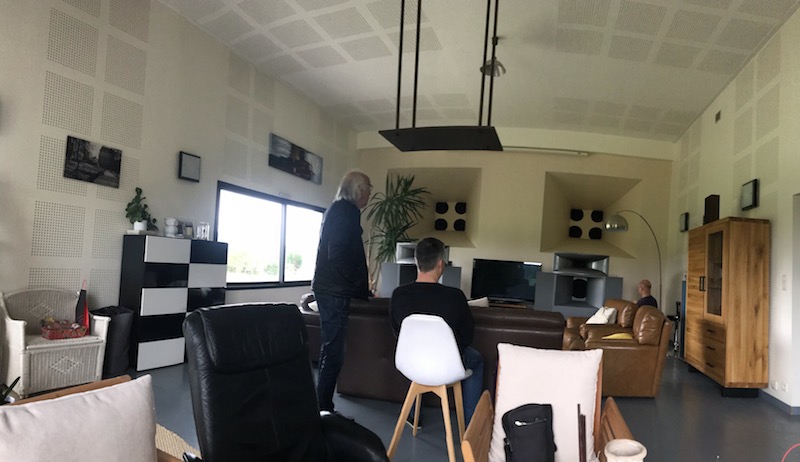
His uncle who led him down the naughty path, Andre, had another beautiful room with Altecs, Voxativ Ampeggio Dues, and Onkens, with his wife playing us some live piano. Both Andre and regis had excellent rooms with the acoustic treatment definitely giving it a sense of air, space, and lack of strain on any frequency. The JBL 2404 at Andre’s caught my attention for giving a wide and airy stage. Regis’ bass power was striking, and I understood from the the three that adding the subs in the wall had improved the ease of flow.
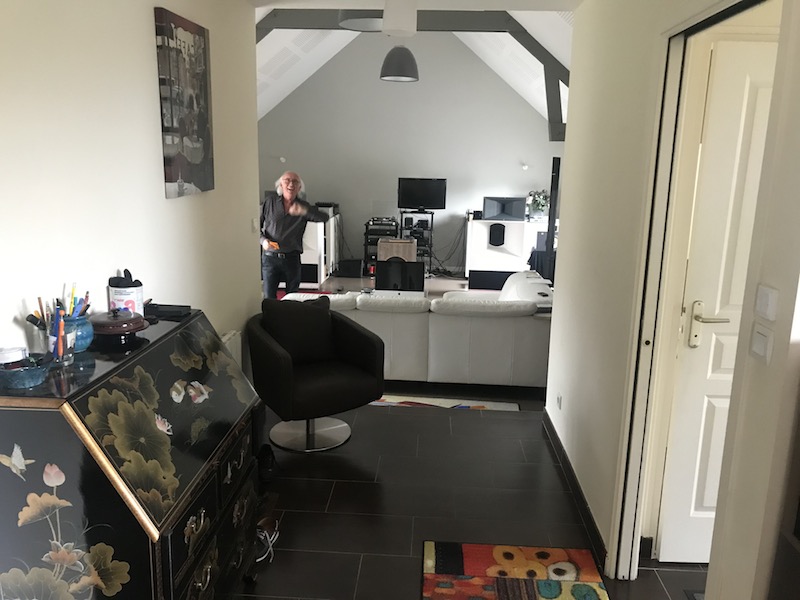
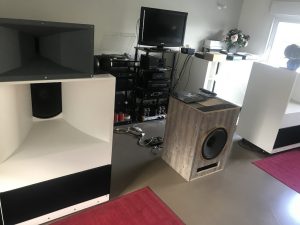
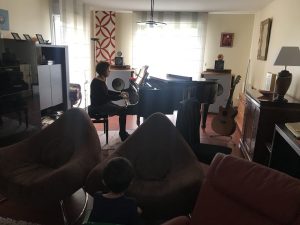
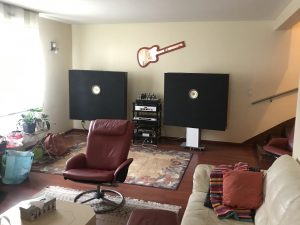
And finally Stephane who had the VOT A5X with original (American) 825 cabinets, mounted with ALTEC 515 (1st serie) reconned by GPA parts (035400), the horn is a H511-E clone equipped by 288-16H GPA completed by T925 FOSTEX. The bass reinforcement is made by 2 ALTEC Model19 (bass box) with ALTEC 421-16G (special britanic model). We did try switching on and off the woofer, and switching it off led to a fall in the soundstage. Both Regis and Stephane had attractive looking Altecs that fit into the living room. Stephane had previously experimented with the Altec 211, but that mammoth beast had proved too much for his room to tame.
What you see with the Altecs in France, are the one woofer VOTs, while Misho’s was the dual woofer front loaded horn.
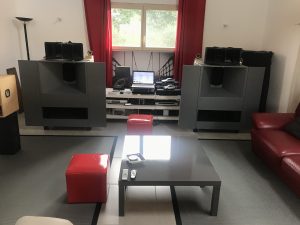
One of the non Altec VOTT systems that sounded quite musical was the Yamaha dual woofer, owned by Dominic in Cologne, described here http://unepassionaudiophile.fr/mon-systeme-audio/
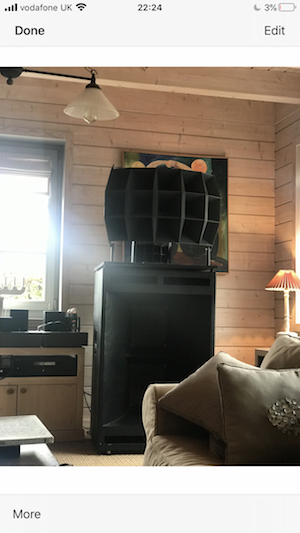
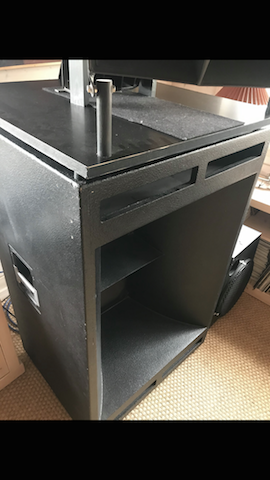
However, at the end, I preferred Misho’s simple series crossovers and electronics over the Hiraga implemenations I heard, and the differences were substantial. If they have to do with series and parallel, and any complexity, I do not know. One thing is for sure, Misho is one of the mentors in audio, who knows how to create an exciting, energetic, large scale natural concert house with his electronics and speaker configurations. . While Misho’s electronics were not DHT triodes like 2a3 or 45 or 46, they were characterized by massive drive, excitement, large stage, and dynamics. Each of the owners I spoke to, all described it as live. You did not get into the nitty gritties of audiophilia, but just appreciated the liveness of the sound.
The people I consulted asked me to stick to the originals over GPA Altecs or recones. By now, I have sourced myself two pairs of original Altec 515Bs (alnicos). If there is one thing I desire more from the altecs, and this is coming from being an anal critical listener who looks for transparency to recordings, nuance in violin tones and inflections, and an electrostatic purity – not something that is on the selection criteria list for every listener – was that the Altec highs lagged behind the Beryllium highs (Radians of horns universums and various TADs) and AER. In either case, as a complete speaker, I prefer these to all OMA speakers, all Cessaro speakers, AG Trios, and Acapellas, Tune Audio that I have heard. Can these be improved using same mid/high drivers as those used in Cessaros or Universums? I will address this in my write-ups to follow. But that whole live experience still makes Misho and Yanislav’s system one of the best I have heard, and what I will probably end up owning once I get sufficient space, with a twist or two on the mids/highs, that is purely optional.
Btw, forgot to mention. Misho turned out to be one of the most selfless, helpful, nicest guys in audio.

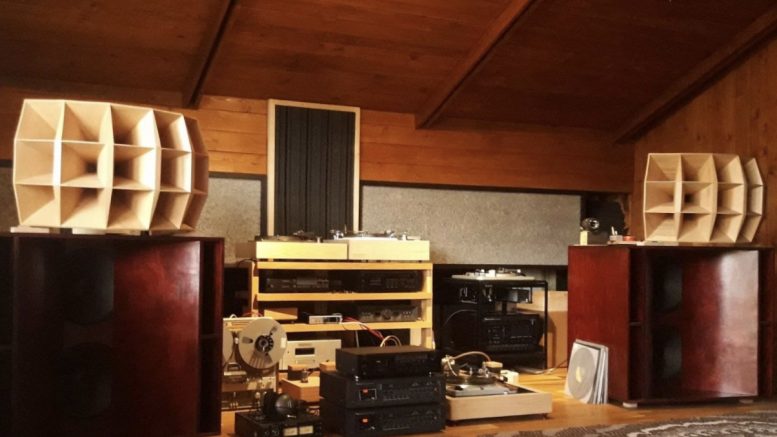
Be the first to comment on "Altec Assault and the Magic of Misho"